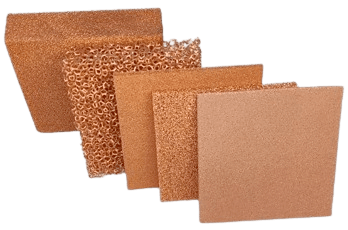Menu
MetalsTek Engineering’s dedication to innovation ensures the continuous development and enhancement of its Copper Foam Sponge product line.

Material: Copper, Cu
Shape: Sheet, Belt, or Customized
Size: Thickness 0.1~100mm * Width * Length
Porosity: ≥70%
Pore Size: 5~130ppi, 30~5,000um
Compressive strength | 131psi |
Tensile strength | 1,000psi |
Shear strength | 190psi |
Vickers hardness | 35 |
Specific heat | 0.385J/g-°C |
Melting point | 1,080°C |
Thermal expansion coefficient | 1.7×10-5 m / m-°C (0-100°C) |
Modulus of elasticity (tension) | 14.6 × 103 psi |

Material: Nickel Copper
Shape: Sheet, Belt, or Customized
Size: Thickness 1~30mm * Width * Length
Porosity: 50%~98%
Pore Size: 5~150ppi, or Customized
Copper Foam Sponge, also known as metallic foam or copper foam, is a unique material characterized by its porous structure with interconnected voids and high surface area-to-volume ratio. This foam is produced by impregnating a metallic skeleton with a blowing agent and then heating it to remove the agent, resulting in a structure of metallic struts and pores. Copper foam exhibits remarkable properties such as high thermal conductivity, excellent electromagnetic shielding, and superior energy absorption capacity. Due to its lightweight nature and exceptional properties, copper foam finds applications in various industries ranging from aerospace and automotive to electronics and energy.
Copper Foam can be used to prepare battery anode materials, catalyst carriers, and electromagnetic shielding materials. Copper Foam is used as the base material of the battery as the electrode, which has some obvious advantages, but the corrosion resistance of copper is not as good as that of nickel, which limits some of its applications.
Our Copper Foams are clearly labeled externally to ensure efficient identification and quality control. We take great care to prevent any damage during storage or transportation.